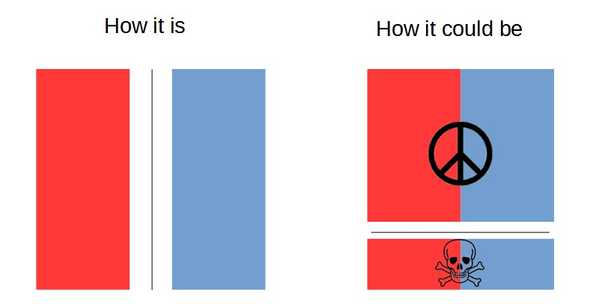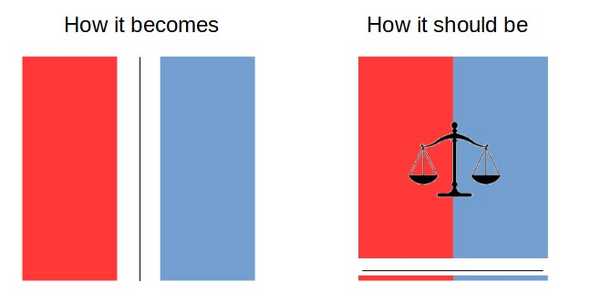We are so tribal, yet doing it so poorly
20 Feb, 2024We are fundamentally inclined to form tribes which, inevitably, conflicts. Because the other team is different, in some way, shape, or form.
We tend to team up based on things that are easily identifiable. After all, from a survival perspective, it is important to quickly identify friend and foe. And so we fight so many conflicts over skin color, ethnicity, religion, etc.
Despite our tendencies to tear each other based on those characteristics, I have a dream. What if we could re-organize teams by adding a dimension, depending on each conflict? A dimension, that, in each case, would actually be the key principle (e.g. a core outcome) that matters rather than a superficial variable (e.g. skin color). If we have to team, we could team up in a way much more meaningful. I will try to keep examples at a high level enough to not trigger existing team biases, so please forgive the intentional blurriness.
1) Wars
Team Blue is involved in a difficult geopolitical war with team Red. People feel they have to take sides, teams solidify, and soon enough, everyone supporting the other color is demonized, while everyone in the same team is “perfect”. It’s like one side has to be fundamentally “right”, while the other is “wrong”. I understand some of the reasons we do this, but it leads to absolutism, radicalization, and hatred. Overall, it contribute to further solidifying the conflict into a vicious circle.
And we know there’s no “perfect”, we know there are beautiful and horrible people on both sides, with rights and wrongs on both sides. So what if we could split people not into blue and red, but rather between “pro-war” and “pro-peace” in this case? In the current situation, belligerent and extreme people on either side thrive, at the expense of pacifists and moderates, which end up lumped with them. A pacifism division would allow values-aligned teams and a more meaningful “conflict”. I do appreciate it is of course easier to identify red/blue, rather than a genuine desire for peace. But in the same way we made religion, something conceptual, physically visible, why couldn’t we do the same with pacifism? Why instead of having to “pick a side between red and blue” about who’s “wrong”, why can’t we pick the pacifist side, and denounce the warring one, independently of their respective geopolitical affiliation? And to do so, not just as a stance, but implementing it in communities, events, and actions, while truly discarding the red/blue dimensions.
It is, of course, a lot easier said than done, and often practically close to impossible. One of the issues is that we have ready-made grouping for red/blue, but not yet a standardized community for pacifism in specific conflicts, e.g. However, I do believe we should keep that separation in mind when discussing the issue, if not as a pragmatic goal, at least as a moral compass.
2) Unfair Discrimination
Let’s say we have a group of people, which could be divided into Xs and Ys, with some cultural or economic disparities between them, and a certain level of societal discrimination. While it could be easy to fight about who’s most privileged or unfairly treated between X and Y, I believe it could be tremendously counterproductive. Because once again, there is a certain amount of unfairness on both parties, there will always be people at a disadvantage and discriminated unfairly on both sides. And trying to accurately quantify is not just nearly impossible, but also potentially a waste of resources. Because the key issue in this situation is unfair discrimination. Shouldn’t we draw a line on who discriminates, and then fight a conflict of the people who don’t against all the people who do?
Another example, Let’s say we have a population with two groups again, red and blue. Because of historical reasons of unfair treatment by some reds, blues tend to be more poor. One day, the media starts highlighting criminal activities, seemingly disproportionately from blue people. What happens? Red and blue start polarizing and opposing each other. Why? Again, I know it’s because it’s such a convenient team-up and the history. But in this case, the issue is not red vs blue, it is and always has been criminals vs innocents. There are criminals on both sides, both sides are suffering because of them, and criminality is the key variable. And this example is a great way to show that the key issue is not directly causal with inherent characteristics from being a certain skin color/culture/ethnicity. Here blues tendency to be poorer was an external causal reason, not inherent to blues nor wanted by them. And we know that inequalities drive criminality. So in this simplified example, the solution is to work on reducing criminality, which amongst other things, means reducing inequalities. Segregating and unfairly treating blues will just amplify the problem rather than contribute to better outcomes for everyone.
This division makes even more sense here than in the other examples, as the ratio of criminals to the general population is very small, leading this to kind of visualization:
I do realize there are historical legacies that have made those groupings by X/Y, red/blue, entrenched into cultures, societies, and sometimes legal systems. But besides the argument that we are used to it, was that ever a good way to divide people? Would we pick it if we were to design a system from scratch?
Political divide
Adding a dimension can also be tremendously beneficial in a polarized political landscape. I have seen people who think they are worlds apart often very close in terms of anti-corruption, freedom, care, and basic human rights. Instead of fighting between two giant masses of overall political leaning, we could try to think of the key values, see on which we align, which are actually the key issues, and then realize there are people pro and against that key issue belong on both “teams”.
In the last few examples, I suggested adding a single dimension, to bring nuance into often binary simplified conflicts. Conflicts which are often forced on variables that are not the one that matters. However, there is no reason to stop there, issues are super complex and multidimensional, as are people. I believe the more we practice adding dimensions that allow to fight on what actually matters, the more constructive we can address those key issues, the more nuanced our perceptions become, and the more we can defuse the vicious circles of absolute perspectives.
I always welcome your thoughts and insights, connect with me on Linkedin!

